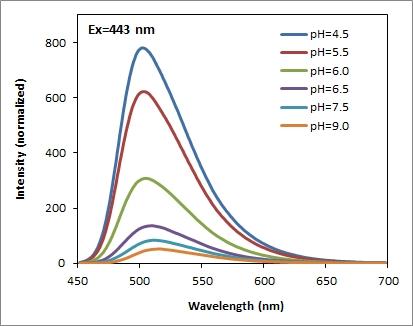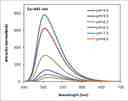Protonex™ Green 500WS
Protonex™ Green dye demonstrated pH-dependent fluorescence. Unlike most of the existing fluorescent dyes that are more fluorescent at higher pH, acidic conditions enhance the fluorescence of Protonex™ Green dye. The fluorescence of Protonex™ Green dye significantly increases as pH decreases from neutral to the acidic. Protonex™ Green dye provides a powerful tool to monitor acidic cell compartments such as endosomes, lysosomes and other biological targets. Protonex™ Green 500 WS is not permeable to live cells, enabling the specific detection of extracellular acidic biological targets. Protonex™ Green has the spectral properties similar to those of FITC, making the common filter set of FITC readily available to the assays of Protonex™ Green.
Calculators
Common stock solution preparation
Table 1. Volume of DMSO needed to reconstitute specific mass of Protonex™ Green 500WS to given concentration. Note that volume is only for preparing stock solution. Refer to sample experimental protocol for appropriate experimental/physiological buffers.
| 0.1 mg | 0.5 mg | 1 mg | 5 mg | 10 mg | |
| 1 mM | 128.927 µL | 644.637 µL | 1.289 mL | 6.446 mL | 12.893 mL |
| 5 mM | 25.785 µL | 128.927 µL | 257.855 µL | 1.289 mL | 2.579 mL |
| 10 mM | 12.893 µL | 64.464 µL | 128.927 µL | 644.637 µL | 1.289 mL |
Molarity calculator
Enter any two values (mass, volume, concentration) to calculate the third.
| Mass (Calculate) | Molecular weight | Volume (Calculate) | Concentration (Calculate) | Moles | ||||
| / | = | x | = |
Spectrum
Product family
| Name | Excitation (nm) | Emission (nm) | Extinction coefficient (cm -1 M -1) |
| Protonex™ Green 500 | 445 | 503 | 4000 |
Citations
View all 20 citations: Citation Explorer
Starch-regulated copper-terephthalic acid as a pH/hydrogen peroxide simultaneous-responsive fluorescent probe for lysosome imaging
Authors: Chen, J., Si, Y., Liu, Y., Wang, S., Wang, S., Zhang, Y., Yang, B., Zhang, Z., Zhang, S.
Journal: Dalton Trans (2019): 13017-13025
Authors: Chen, J., Si, Y., Liu, Y., Wang, S., Wang, S., Zhang, Y., Yang, B., Zhang, Z., Zhang, S.
Journal: Dalton Trans (2019): 13017-13025
A structure optimized fluorescent probe for highly sensitive monitoring drug induced lysosomal pH value changes
Authors: Gong, Y. J., Kong, Z. Z., Zhang, M. L., Lv, M. K., Zhang, G.
Journal: Talanta (2019): 1-8
Authors: Gong, Y. J., Kong, Z. Z., Zhang, M. L., Lv, M. K., Zhang, G.
Journal: Talanta (2019): 1-8
An effective FRET-based two-photon ratiometric fluorescent probe with double well-resolved emission bands for lysosomal pH changes in living cells and zebrafish
Authors: Yuan, G., Ding, H., Zhou, L.
Journal: Spectrochim Acta A Mol Biomol Spectrosc (2019): 117397
Authors: Yuan, G., Ding, H., Zhou, L.
Journal: Spectrochim Acta A Mol Biomol Spectrosc (2019): 117397
A pH probe inhibits senescence in mesenchymal stem cells
Authors: Wang, L., Han, X., Qu, G., Su, L., Zhao, B., Miao, J.
Journal: Stem Cell Res Ther (2018): 343
Authors: Wang, L., Han, X., Qu, G., Su, L., Zhao, B., Miao, J.
Journal: Stem Cell Res Ther (2018): 343
Dual site-controlled two-photon fluorescent probe for the imaging of lysosomal pH in living cells
Authors: Wang, C., Dong, B., Kong, X., Zhang, N., Song, W., Lin, W.
Journal: Luminescence (2018): 1275-1280
Authors: Wang, C., Dong, B., Kong, X., Zhang, N., Song, W., Lin, W.
Journal: Luminescence (2018): 1275-1280
Page updated on August 28, 2025



